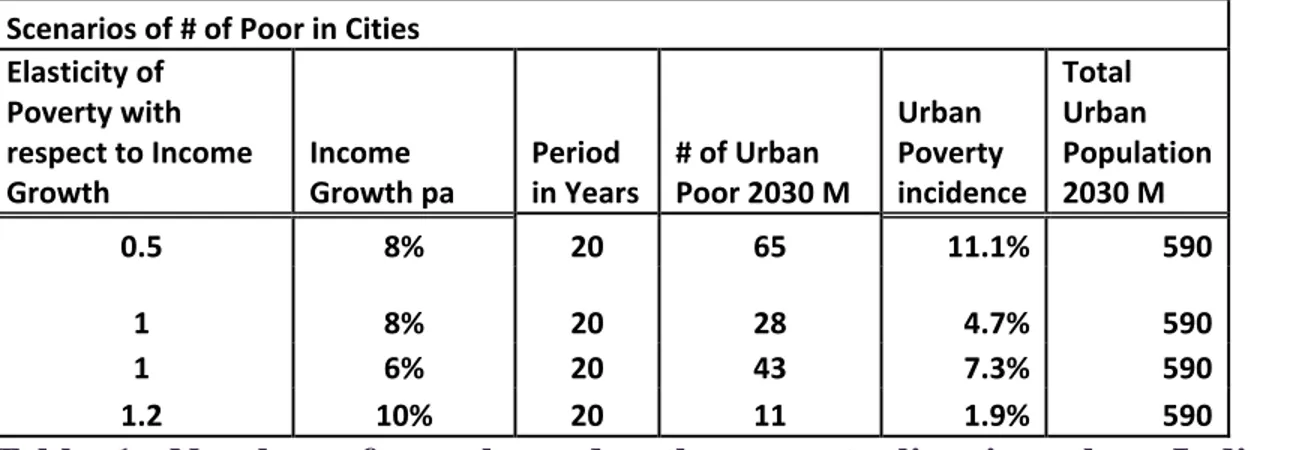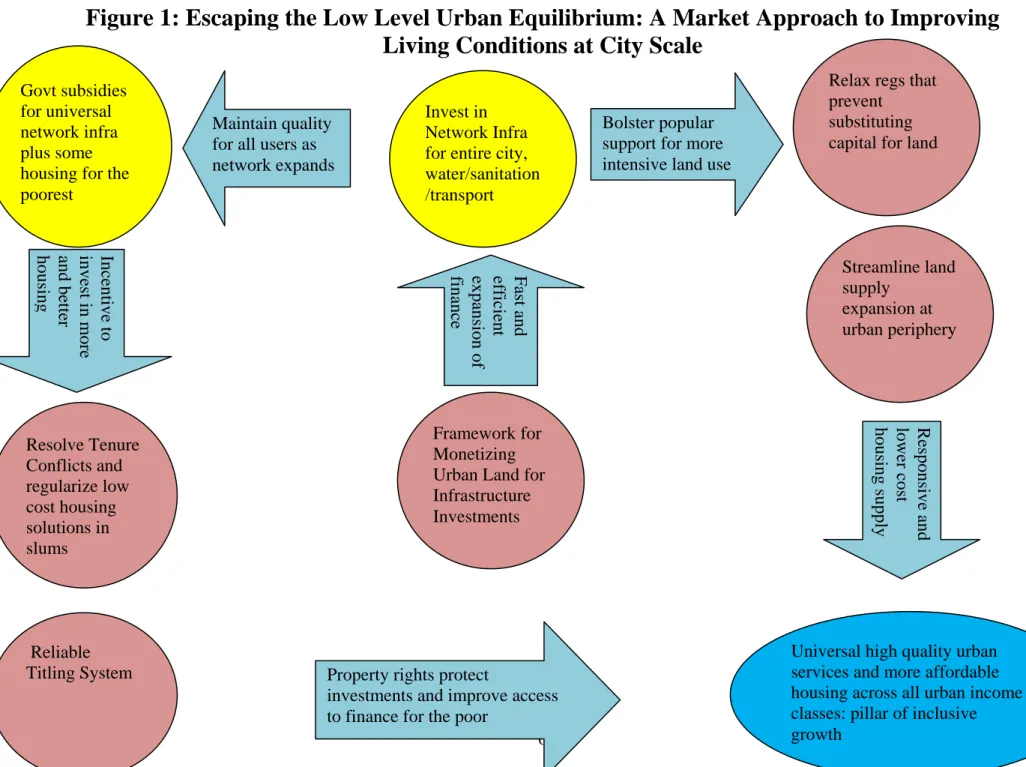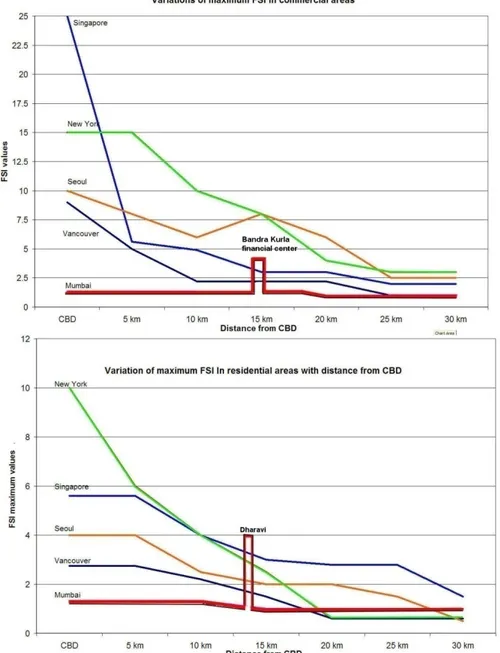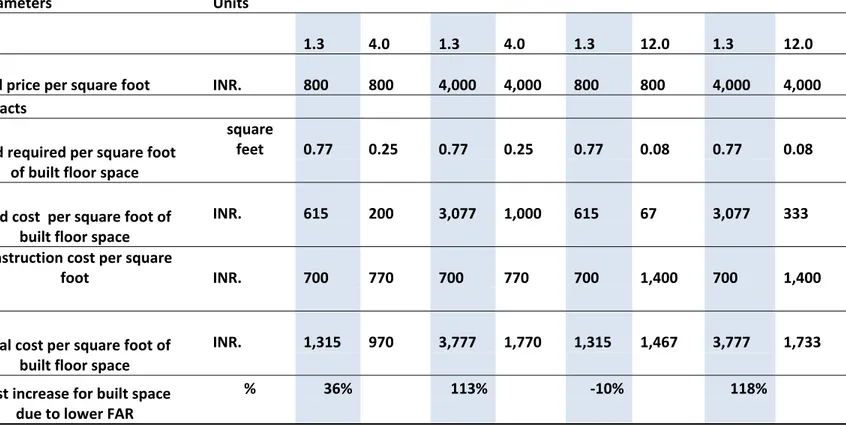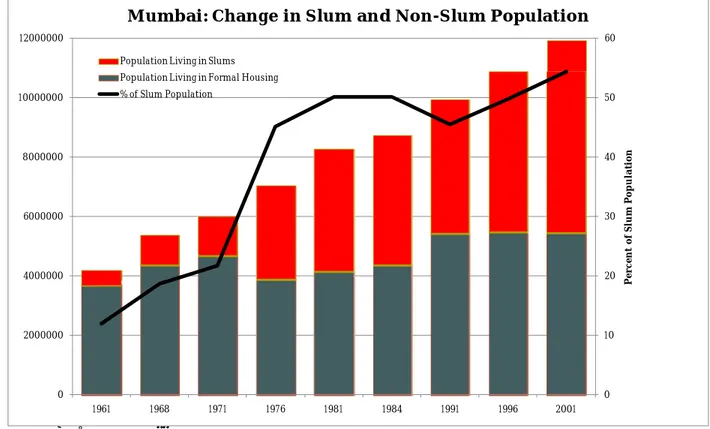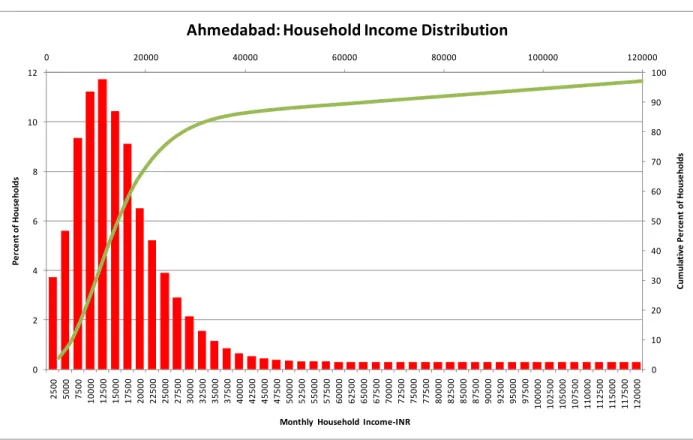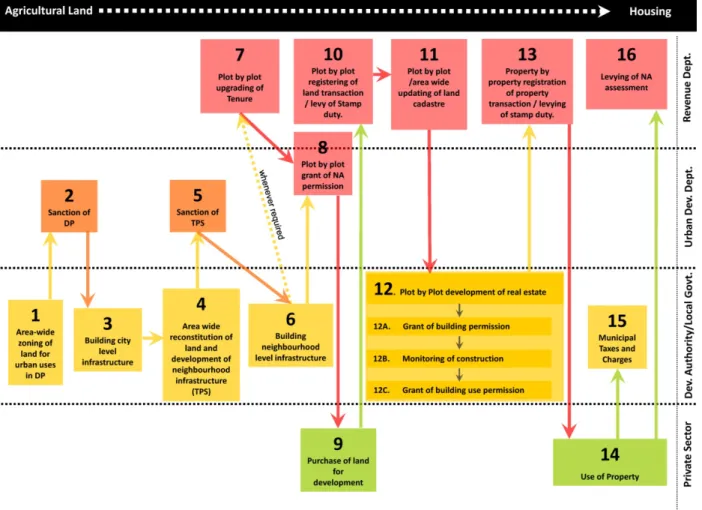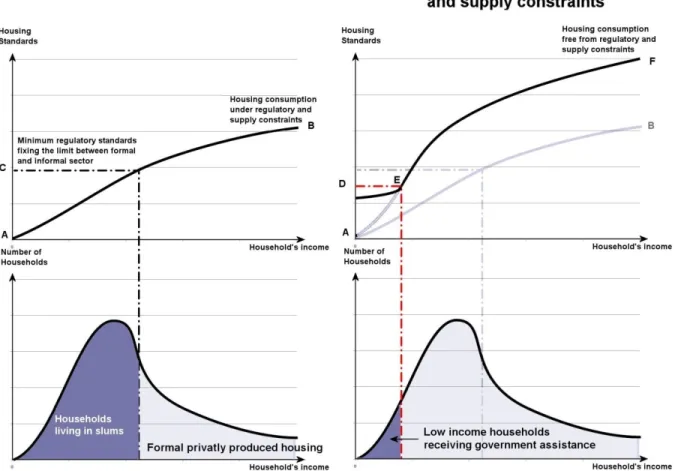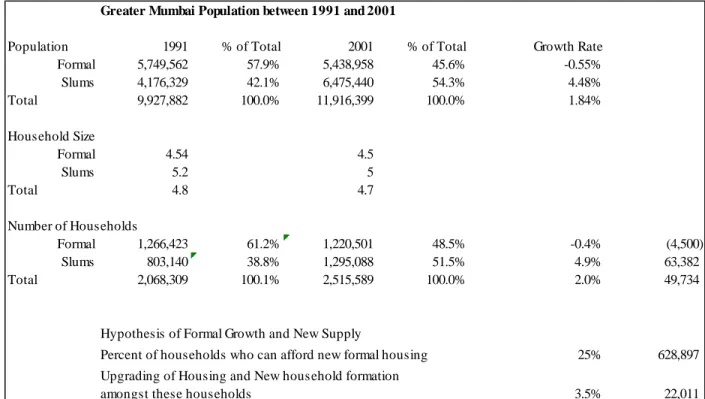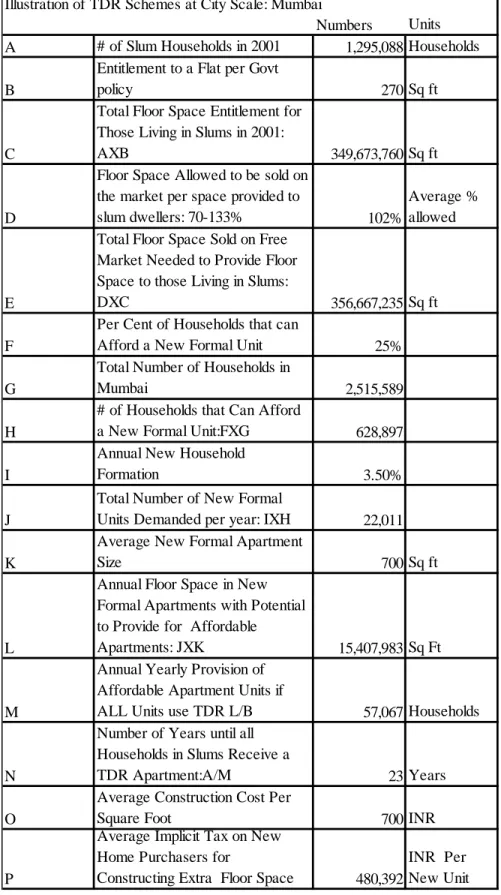Policy Research Working Paper 5475
Working with the Market
Approach to Reducing Urban Slums in India
Patricia Clarke Annez Alain Bertaud
Bimal Patel V. K. Phatak
The World Bank
Sustainable Development Network
Finance, Economics and Urban Development Department November 2010
Public Disclosure AuthorizedPublic Disclosure AuthorizedPublic Disclosure AuthorizedPublic Disclosure Authorized
Produced by the Research Support Team
Abstract
The Policy Research Working Paper Series disseminates the findings of work in progress to encourage the exchange of ideas about development issues. An objective of the series is to get the findings out quickly, even if the presentations are less than fully polished. The papers carry the names of the authors and should be cited accordingly. The findings, interpretations, and conclusions expressed in this paper are entirely those of the authors. They do not necessarily represent the views of the International Bank for Reconstruction and Development/World Bank and its affiliated organizations, or those of the Executive Directors of the World Bank or the governments they represent.
This paper examines the policy options for India as it seeks to improve living conditions of the poor on a large scale and reduce the population in slums. Addressing the problem requires first a diagnosis of the market at the city level and a recognition that government interventions, rather than thwarting the operations of the market, should seek to make it operate better. This can substantially reduce the subsidies required to assist low income households to attain decent living standards. The authors show that government programs that directly provide housing would cost, in conservative estimates, about of 20 to 30 percent of GDP, and cannot solve a problem on the scale of India’s. Using two case studies,
This paper—a product of a collaboration of the Finance, Economics and Urban Development Department, Sustainable Development Network and the Wolfensohn Center for Development at the Brookings Institution—is part of a larger effort in the department to identify effective approaches for improving living conditions of the poor in cities at a large scale.
Policy Research Working Papers are also posted on the Web at http://econ.worldbank.org. The authors may be contacted at pannez@worldbank.org, duatreb@msn.com, architect.planner@gmail.com, and vidyadhar.phatak09@gmail.com.
for Mumbai and Ahmedabad, the paper offers a critical examination of government policies that shape the real estate market and make formal housing unaffordable for a large part of the population. It illustrates how simple city level market diagnostics can be used to identify policy changes and design smaller assistance programs that can reach the poor. The linkage between chronic infrastructure backlogs and policies makes housing unnecessarily expensive. Increasing the carrying capacity of cities is essential for gaining acceptance of real estate policies suited to Indian cities. The authors propose approaches for funding major investments to achieve this.
“Working with the Market: A New Approach to Reducing Urban Slums in
India”
Patricia Annez, Alain Bertaud, Bimal Patel and V. K. Phatak
11 Brookings Institution/World Bank, Independent Consultant, Environmental Planning Collaborative, and
Independent Consultant respectively. Views expressed are personal and do not necessarily represent the policies of the Brookings Institution or the World Bank. The comments of many reviewers and participants in a seminar at the National Institute of Urban Affairs in India have been of great benefit to the authors.They would like to thank the Rockefeller Foundation for financial support to conduct this research.
A. Introduction
Two powerful principles have guided urban land management policies in India, at least since the 1970s. First, keeping India’s cities livable means discouraging people from coming to large cities and distributing growth to rural areas and small secondary cities. Second, planning and other regulatory and financial policies coupled with rationing of urban services will actually prevent people from moving to cities and hence make them more livable. Together, these two principles are part of a broader philosophy underlying the thicket of policies commonly referred to as the “license raj” that grew up after Independence in India. This contrasts to the overall policy approach post reform in 1991, which—very successfully—
unleashed the sources of economic growth and sought to manage economic decisions less directly. Here, we argue that, whatever their merits in the past, existing urban land management policies that seek to control the urban land market tightly are no longer suited to an India which is growing at rates exceeding 8% for sustained periods and in which 70% of new employment is generated in its cities.
These policies have made formal housing expensive and unattainable to a large share of the population, reinforced both chronic urban infrastructure shortages city- wide and squalid, precarious living conditions in urban slums.
The government of India (GoI) is to be applauded for wishing to turn this around-- taking on the ambitious and worthwhile task of dramatically improving living conditions in India’s cities, with the ultimate goal of Cities without Slums.
Substantial increases in central budgetary support to major programs that will improve slums in Indian cities are in the works. It is timely to consider the design of a major program shift such as this. In spite of India’s rapid growth, ensuring that good housing standards are affordable to all who wish to live in cities will probably take a generation, and getting off to the right start with the first major central slum program is key.
As we argue below, a housing policy that supports “cities without slums” should
involve: (1) making the market work better so that market-priced housing is more
affordable; and (2) subsidies targeted primarily to the substantial share of the urban
population that will still be too poor to afford socially acceptable minimum shelter
conditions. Assistance to all those households, even if targeted carefully, will be
large in relation to fiscal capacity. This paper proposes an approach designed to
make the lofty goal of improving living conditions for all of India’s urban poor
attainable, and maximize the effectiveness of government resources dedicated to
this effort.
Without government action, slum populations can be expected to grow in urban India even in the face of rapid income growth. Table 1 illustrates a variety of scenarios for populations under the poverty line in India. These scenarios use the population projections from McKinsey (2010) and draw from the range of estimates of the elasticity of poverty headcount percentages with respect to economic growth. (Murgai and Zagha: 2010). Even with sustained rapid income growth, millions in cities are likely to remain poor and be unable to afford access to formal housing. This is because the urban population in India is due to grow considerably over the next 20 years. Even with rapid income growth, and much lower poverty incidence, the numbers of poor people in cities will continue to be substantial. Even with the arguably implausibly optimistic scenario of reaching a 2% poverty incidence in India’s cities, 11 million people will be poor. A more likely scenario suggests that twenty years from now, somewhere between 30 and 40 million people in urban India will be poor, even if the economy performs very well over the long term.
Scenarios of # of Poor in Cities Elasticity of
Poverty with respect to Income Growth
Income Growth pa
Period in Years
# of Urban Poor 2030 M
Urban Poverty incidence
Total Urban Population 2030 M
0.5 8% 20 65 11.1% 590
1 8% 20 28 4.7% 590
1 6% 20 43 7.3% 590
1.2 10% 20 11 1.9% 590
Table 1: Number of people under the poverty line in urban India under different poverty elasticity assumptions Source: Authors’ calculations.
This paper outlines a new strategy in four main sections:
1) Shaping the market to ‘right-size’ the need for subsidies. The supply of
urban real estate markets in India is deeply constrained by misguided or
outdated government policies. These policies have a dramatic effect on
prices and the quite unsurprising result is by far the largest slum
population of any country in the world. India’s vast and growing slums
are not an inevitable result of fast urban growth or poverty. Vietnam’s
cities are growing at twice the rate in India, per capita income is roughly
similar, but the incidence of slums is much smaller. Other once-poor Asian countries like Thailand have passed through the early phases of their urban transition with far smaller slum populations. Hong Kong SAR, China, accommodated one of the most rapid influxes of poor migrants in the 1950s and 1960s, while rapidly accommodating them in decent housing. If India wishes to deal with the slum problem on a large scale, it must wind down the phalanx of policies that artificially raise the price of housing and make the slum problem larger than it need be. The first section discusses these distortions and their impacts.
2) Shortcuts to reform through direct housing provision: Can they work?
The very distortions that restrict supply and inflate the cost of housing also give the impression that there are affordable shortcuts to the market reforms and targeted subsidies. Ideas like cross subsidizing housing for slum dwellers out of the costs of putting up new housing developments for the non-poor
2are popular with governments around the world, because they have no visible budgetary costs. In India, they are particularly attractive because supply is so tightly rationed and housing prices so inflated that often developers will accept these implicit taxes without complaint. Their costs can easily be passed on to buyers.
Because slums have grown so rapidly in the face of rising prosperity, many have come to believe that a rights-driven approach for national standards of decent housing funded by central subsidies can eradicate slums. In this section we show that these ‘solutions’ are both prohibitively expensive and even under the most favorable assumptions would take a generation to complete the enormous task of housing the current slum population. Such programs are likely to shift the affordability problem from households to governments. They may offer expansive promises, but will fail to deliver. A few lucky or well connected beneficiaries will receive a deep subsidy while the majority of the target population will be excluded.
3) One size does not fit all: Illustration from case studies of Ahmedabad and Mumbai. In this section, we examine data on the housing market outcomes, prices, sizes and locations of homes, plus specific constraints to supply in each city. This analysis demonstrates that an efficient
2 In India, these most commonly take the form of reservations requiring a certain percentage of houses for the poor to be built in all new developments (one of the JNNURM reforms) or else provision of regulatory relief against provision of homes to low-income groups (TDR schemes).
approach to subsidizing a minimum shelter
3standard across all Indian cities must take into account market conditions specific to each city. We demonstrate how this analysis can be used to determine the scope, design and cost of government assistance to address the slum problem in a given city.
4) Key elements for government slum policy. In conclusion, the findings from the first three sections are recapitulated to discuss the key elements of a strategy for improving the living conditions for slum dwellers on a large scale—and city by city. Figure 1 below recapitulates the key elements of such a strategy.
3 We refer to shelter here because it includes not only housing but basic services that provide environmental amenities to households such as safe water and clean and safe streets. In India, these services are rationed all over the country and are of higher priority for government programs because these are much more problematic and more expensive for individuals to provide on their own.
6
Figure 1: Escaping the Low Level Urban Equilibrium: A Market Approach to Improving Living Conditions at City Scale
Streamline land supply
expansion at urban periphery Relax regs that prevent
substituting capital for land Invest in
Network Infra for entire city, water/sanitation /transport
Resolve Tenure Conflicts and regularize low cost housing solutions in slums
Govt subsidies for universal network infra plus some housing for the poorest
Framework for Monetizing Urban Land for Infrastructure Investments
Reliable Titling System
Bolster popular support for more intensive land use
Fast and efficien t expansion of finance Responsive and lower cost housing supply
Incentive to invest in mo re and better housin g
Property rights protect
investments and improve access to finance for the poor
Universal high quality urban services and more affordable housing across all urban income classes: pillar of inclusive growth
Maintain quality for all users as network expands
7
B. Rightsizing the Need for Subsidies to Slum Dwellers The growth of slums is a market response.
Contrary to the conventional view, the existence of slums is not necessarily a sign that markets cannot provide housing to low-income households. The existence of slums demonstrates that the private informal sector is able to devise housing solutions for even the lowest income groups. Governments have an important role to play, however, in determining the penalties paid for living in low-cost housing.
They determine, by setting standards that raise costs, how much low cost housing is informal and thus illegal. They determine whether informal low-cost settlements get basic services. Governments also decide on which protections they extend under the law for acquired property rights and investments in informal structures.
Likewise government policies shape many the cost drivers of private sector supply response, and thus determine the share of total housing demand that can be met in the formal sector, and how much must be met by informal slum settlements.
Why is the share of the informal housing sector increasing in India while urban productivity and households’ income have been steadily increasing over the last 20 years? Regulatory constraints and land supply bottlenecks created by government prevent the formal housing market from offering products that low-income groups can afford. Dramatic under-provision of network infrastructure that accommodates intensive land use and permits concentration of population where people want and need to live considerably compounds the problem. It reinforces pressures to regulate the supply of built space and rations access to basic environmental services in informal settlements. Removing these constraints could enable the formal sector to meet a much larger part of the demand of households currently living in slums. Government policy can also reduce the vulnerability of those who still can only afford to live in informal settlements.
The appropriate frame of reference for policies to reduce the slum problem is the potential supply response across the entire housing stock.
Slums are not static entities. New households move into slums every day. The new
comers may be new migrants to the city or households who can no longer afford
formal housing. Some households currently living in slums may be able to leave
them and move to formal housing. Some slums may be improved to the point that
when their tenure is formalized, and their standards are similar to formal housing.
8
The formal housing stock is not static either. High income households tend to move up the housing scale, moving from older units to newer and more modern ones. In doing so, higher income households free up the older housing stock. These older units can then be used by middle income groups, who are themselves moving up market, freeing dwelling units in less desirable areas. These older units vacated by middle income groups are precisely the ones that would allow the more affluent slum dwellers to move out of slums and afford older units in the formal market. It is also likely that older housing units are better located for access to jobs than units in new greenfield developments.
This dynamic illustrates why it is counterproductive to constrain or tax high end development to “promote” low cost housing. The effect is likely to be just the opposite. Production of new housing for higher income groups at lower costs has a positive effect on the entire housing supply. Taxing it implicitly with cross subsidies does the opposite. Removing rigidities at any point in urban real estate supply chain can improve the availability of low-income housing. Restricting supply pushes higher income groups into the rehabilitation of older homes, which could instead have become moderately priced lower quality housing. This older inner city housing stock vacated by higher income groups might constitute a more attractive solution than new suburban developments for lower income groups who lack the mobility of more affluent households.
Removing rigidities that prevent these market responses to shifting demands is an important part of affordable housing policy--more important even than direct provision of public housing. In the dynamic economy of India, it is important to monitor these movements of households city by city as incomes increase.
Monitoring these flows can then help to gauge the success of market oriented policies. For example, in Mumbai, as will be discussed in more detail later, the absolute decline of formal housing and the rapid increase in slum populations over ten years of strong income growth should send a blinking red alarm signal that supply side policies need to be revamped.
How urban policies have constrained the private sector housing supply
response in India
9
Policies that affect urban land use are at the heart of supply constraints. Urban agglomeration economies are derived from locating in close proximity to other productive activities. One of the most important features of any residence is location close to jobs, services and amenities. As such, well located urban built space is a valuable factor of production for all urban economic activities and workers, and its price will be determined in a fierce competition amongst all possible uses. Well located land is necessarily limited in any city. In India, government policies further constrain the supply of land and floor space while also inflating demand for land by:
1) Reducing the scope for substituting capital (building more stories) for land 2) Imposing rigid requirements on consumption of land per area of usable built
space with little regard to its costs in terms of affordability
3) Raising the costs and time required for expanding land at the urban periphery.
4) Freezing use of prime land for redevelopment regardless of its market value, due either to public ownership, pervasive reservations of private lands, tight regulations that make existing land use illegal, or ambiguities in land tenure.
5) Chronically underinvesting in network and connectivity infrastructure that permits a manageable and productive increase in urban densities.
Substituting capital for land
The typical solution to scarce and costly urban land is to substitute a cheaper and more readily expandable factor, capital, for land by building multiple stories. This permits production of more floor space in good locations. Rules that limit the amount of floor space that can be built on a given piece of land reduce the availability of well located floor space and bid up the supply price of a given amount of floor area provided in cities to meet all demands, including housing.
This particular regulation is commonly referred to as a maximum floor area ratio (FAR)
4. Most countries use maximum permissible FARs, but the FARs in large Indian cities are small fractions of those used in most other large cities in the world, including in other low and middle income countries. The low values for FAR in many cities of India are exceptional as can be seen in Figure 2. These low FAR in India also vary little with distance from the city center unlike most other countries.
4 Also referred to as maximum floor space index (FSI). These two are used interchangeably in this paper.
10
Figure 2: FAR variations with distance in Mumbai and other cities in the world
Table 2 illustrates how reducing FARs can raise the costs of providing living
space. This example uses land values representing relatively low and higher values
for large metro cities like Delhi or Mumbai and taking reasonable estimates for the
costs of basic standard construction and the impacts of building much higher in the
high FAR case. It illustrates that low maximum FAR’s can increase costs above
what the market would choose to supply in areas with higher land costs. This table
also illustrates the impact of FAR on aggregate demand for land. Employers and
11
households demand a certain amount of space to live and conduct business in the city. When FAR’s are kept low, much more land is required for a given amount of office or residential space. High prices will of course compress the demand for space, but not completely, so low maximum FARs result both in spread out cities and unnecessarily high land prices.
Table 2. Scenarios Comparing Impact of Lower and Higher FAR on Costs at Different Land Prices
Parameters Units
FAR
1.3
4.0
1.3
4.0
1.3
12.0
1.3
12.0 land price per square foot INR.
800
800
4,000
4,000
800
800
4,000
4,000
Impacts
land required per square foot of built floor space
square feet
0.77
0.25
0.77
0.25
0.77
0.08
0.77
0.08
land cost per square foot of built floor space
INR.
615
200
3,077
1,000
615
67
3,077
333
construction cost per square
foot INR.
700
770
700
770
700
1,400
700
1,400
total cost per square foot of built floor space
INR.
1,315
970
3,777
1,770
1,315
1,467
3,777
1,733
Cost increase for built space due to lower FAR
% 36% 113% ‐10% 118%
Construction costs assumed to increase by 10% and 100% respectively for 4 and 12 FAR . Land costs are hypothetical.
FAR regulations are not alone in forcing high consumption of land and reducing scope for substitution of capital for land. Minimum plot sizes, regulations
concerning use of elevators, parking, street width, maximum building coverage,
etc. require high consumption of land per unit of usable built space, and thus
contribute to the high cost of formal housing. Many of these regulations are
normative and not based on any economic assessment of the costs (including the
price of land) they impose on consumers of housing in a given city. In some areas,
these additional restrictions are such that they prevent a developer from using even
all the available FAR. The private formal sector could provide more housing for
low-income groups if these regulations were audited to insure that land use
12
regulations are consistent with purchasing power and urban land costs in different areas of the city. The cost of reserving land for wide streets and parking lots even in areas where most residents don’t own cars and walk in their immediate
neighborhood is much higher in a mega-city like Delhi than a secondary town in a backward area. Yet rarely do the regulations, typically established with strong guidance from the State, reflect the costs imposed by rigid adherence to norms across cities or neighborhoods. (See Annex 1 for some illustrative examples from the Ahmedabad by-laws that make it hard to provide market responsive formal housing for low-income groups.)
Figures3a and b below illustrate the major impact of these regulations on fast- growing economically vibrant cities. In Mumbai, regulations have driven down permitted maximum FARs over the years, with the final reduction in 1991 (ironically coinciding with the dismantling of the license raj in other parts of the economy) to a 1.33 Maximum Allowable FAR for the entire greater Mumbai.
Nearly all of the population increase over time has been absorbed in slums even as income has increased rapidly. Now 54 percent of the population lives in slums.
Mumbai has a much higher share of slum population in spite of being better off. In Ahmedabad, over the period where highly restrictive planning and regulatory policies were pursued, the percentage of the population living in slums grew. (see Box 2). New census information will be very useful to assess the impact of the policy changes that were introduced in Ahmedabad in the 2000 plan.
Figures 4a and b illustrate, showing the household income class distribution for
Mumbai and Ahmedabad.
13
Figure3a. Mumbai --Population living in Formal Dwellings and Slums over Time
Figure 3b. Ahmedabad-Population Living in Formal Dwellings and Slums over time
0 10 20 30 40 50 60
0 2000000 4000000 6000000 8000000 10000000 12000000
1961 1968 1971 1976 1981 1984 1991 1996 2001
Percent of Slum Population
Mumbai: Change in Slum and Non-Slum Population
Population Living in Slums Population Living in Formal Housing
% of Slum Population
0 5 10 15 20 25 30
0 500,000 1,000,000 1,500,000 2,000,000 2,500,000 3,000,000 3,500,000 4,000,000
1971 1981 1991 2001
Percent of Slum Population
Ahmedabad: Change in Slum and Non-Slum Population
Population living in Slums
Population living in Formal Housing
Percent of Slum Population
14
Figure 4a. Income Distribution in AhmedabadFigure 4b. Income Distribution in Mumbai
0 20000 40000 60000 80000 100000 120000
0 10 20 30 40 50 60 70 80 90 100
0 2 4 6 8 10 12
2500 5000 7500 10000 12500 15000 17500 20000 22500 25000 27500 30000 32500 35000 37500 40000 42500 45000 47500 50000 52500 55000 57500 60000 62500 65000 67500 70000 72500 75000 77500 80000 82500 85000 87500 90000 92500 95000 97500 100000 102500 105000 107500 110000 112500 115000 117500 120000 Cumulative Percent of Households
Percent of Households
Monthly Household Income‐INR
Ahmedabad: Household Income Distribution
0 20000 40000 60000 80000 100000 120000
0 10 20 30 40 50 60 70 80 90 100
0 1 2 3 4 5 6 7 8 9 10
2500 5000 7500 10000 12500 15000 17500 20000 22500 25000 27500 30000 32500 35000 37500 40000 42500 45000 47500 50000 52500 55000 57500 60000 62500 65000 67500 70000 72500 75000 77500 80000 82500 85000 87500 90000 92500 95000 97500 100000 102500 105000 107500 110000 112500 115000 117500 120000 Cumulative Percent of Households
Percent of Household
Monthly Household Income _ INR
Mumbai: Household Income Distribution
15
The existing land registration and tenure system freezes land in current use, perpetuates fuzzy property rights that impede investment, and makes expansion of urban land use at the periphery costly and time
consuming.
In India, the transmission of land tenure and changes of land use are subject to multiple layers of legislation, some dating from colonial times. Several government agencies, from ministries of agriculture to the ministries of finance and revenue have to provide an authorization for a simple change from agricultural to urban use, even for lots already within the perimeters of municipalities or development authorities. Oftentimes, urban land transactions require time consuming coordination between state level authorities in the revenue department and local government authorities, whose systems operate on different principles.
Many lots in and around cities are sold and bought in good faith but without always following the intricate procedures required by legislation, These lots are then tainted with a “fuzzy” or dubious title and any sale or re-development of the land will potentially incur high risk and potential law suits or a “stay order”.
Oftentimes either old laws like the Urban Land Ceilings Act, or restrictive land use regulations, now repealed, placed reservations on plots which prevented normal legal transactions or made any formal use of the land illegal. These plots were sometimes rented or “sold” to unsuspecting buyers who were unaware of the restrictions. Meanwhile the original owners sometimes sought to regularize the land use while retaining formal title. This cycle of regulation and creation of “grey rights” results in competing claims on these lands. Because of this legal uncertainty, many urban lots are de facto frozen, preventing formal development or sale transactions. The number of urban lots in Indian cities that are frozen and therefore removed from the formal market is not known, but such frozen plots impede the intensification of land use that is a normal part of the urbanization process. In some cities lots with problematic tenure may amount to a large percentage of the formal land market.
Lots with fuzzy tenure are often located in already urbanized and serviced areas.
The occupants who bought the land but do not have clear tenure are likely to be
able to resist eviction, but they are unlikely to invest in valuable improvements. It
is costly and time consuming to aggregate plots of land in this condition, so
redevelopment is very difficult. Yet these lots are well located and may benefit
from access to existing infrastructure networks. But because these lots are frozen
for formal development, a part of the existing infrastructure cannot be fully used
16
and the municipality or development authority is obliged to develop more land in suburban areas.
In addition, even when land and property titles are clear, the high transaction cost and time involved in transmitting titles act as supply constraints. High stamp duties are not the only transaction costs. The time and expertise required to transmit titles legally might discourage formal transactions for small lots, although these are precisely the type of lots that should be readily marketable. They allow for an efficient expansion of built space in local areas without requiring major infrastructure expansion. Simplifying the procedure for changing land use and transmitting title would increase immediately the number of urban lots that could be developed and would contribute to alleviating the land and floor space shortages in Indian cities.
We illustrate the specific difficulties and types of transactions costs incurred using an analysis of land conversion at the urban periphery taken from Ahmedabad.
Conversion of land at the urban periphery. The topography of the surrounding countryside does not pose an impediment to the expansion of the city. However, before anyone can legally build there, land surrounding the city that is classified as agricultural
5has to be legally converted to urban land. This is a complex process involving a number of physical, cadastral and tenure related transformations.
Completing each of those steps involves a great deal of time, financial outlays, and risks for a developer. These in turn drive costs which must ultimately be built into the price of the final housing product (or commercial or industrial space).
Interest during construction is one of the most important cost drivers for developers. It accounts for about half of total development costs in a typical development project in a relatively expeditious regulatory environment. The cost burden, direct and indirect, of these procedures can be very substantial.
Key steps in the entire process, starting from the conversion of agricultural land up to sale of housing as well as the different agencies involved are listed in Figure 5 below. All new housing provided on the periphery of Ahmedabad must pass through these laborious procedures. The process for redeveloping and intensifying land use on existing plots within the city is similar except that steps 4 to 8 are not relevant—if the plot has already passed through the agricultural to urban conversion process, which is not the case for many plots in the city.
5 By agricultural land, we mean land classified as agricultural. This can be the case where or not the land is under cultivation.
17
Figure 5: Process for Adding to the Housing Stock on the Urban Periphery in Ahmedabad
Sources:
1. From unpublished research project undertaken by Environmental Planning Collaborative, Ahmedabad, 2009. For complementary details see Patel Bimal, et alia (2009)
High minimum regulatory standards not only raise the costs of a legal dwelling and impose heavy costs on lowincome groups: they also block a potential source of investment in lowcost housing.
Households living in slums are penalized in many ways in addition to living in an
unsanitary and crowded environment. These penalties include difficulties of access
to normal urban services ranging from solid waste removal to water supply and
18
sanitation. However, one of the most important social and economic penalties imposed by high standards is the exclusion of slum dwellers’ housing from the protection of the law normally accorded through the property rights system. Any real estate transaction is illegal in slums. Transactions however are indispensable and occur as often in slums as in the formal real estate sector. Any dispute over contracts can be solved only by using force, because contracts passed in the informal sector are unenforceable in a normal court of law. Slum dwellers are also subject to evictions and loss of all they have invested in their homes and land, and may pay regular protection money to avoid this. Yet, one of the best sources of supply of well located low cost housing is current slum dwellers, who, if they have sufficient security of tenure will invest in additional housing space which can be sold or rented out to even lower income groups. Maintaining strict and inflexible standards increases vulnerability and thus cuts off this potential supply. This situation contrasts sharply with urban China, for example, where the urban villages system protects ‘peasant’ landowners who have legal land tenure and who do not need to adhere to normal urban building standards. These villages provide an often very well located supply of low cost rental housing for the low-income population, including migrants. Measures to facilitate some form of parallel formal housing market that permits lower standards in limited areas of a city and provides explicit legal protections for owners of this housing should be considered for India’s cities.
Chronic underinvestment in primary infrastructure and rapid transit impedes development at densities reflecting the economic potential of urban land and makes it very difficult to rationalize land use regulations.
Failure to invest sufficiently in urban infrastructure has greatly contributed to the current shortage of urban built space and extremely high real estate prices.
McKinsey (2010) estimate that Indian cities make annual capital investments of $14 as compared to $116 in Chinese cities. The lack of urban roads and public transport contributes to the fragmentation of urban labor markets and substantially reduces urban productivity. Poor quality public transportation drives people to live near their work, further creating pressure on well-located land. In Indian cities, shortages of water and power, drainage, sewers and proper waste disposal facilities affect all income groups.
Government’s perceived inability to expand and improve infrastructure networks
in response to reasonable demands for urban infrastructure is responsible for what
might be termed a Malthusian view of the carrying capacity of cities. Infrastructure
is so chronically undersupplied, and responds to little to increases in population
and economic activity that it is seen as a fixed resource rather than a set of services
19
managed to meet local demand. The unpopularity of land use reform that would increase the intensity of land use, whether it is to increase FAR or to redevelop obsolete cotton mills, is symptomatic of this view and quite understandable.
Without very substantial improvements of basic infrastructure services that eliminate the chronic shortages that all urban users face, it is more than likely that any increase in local density will be perceived as decreasing the availability, quality, and reliability of basic services for those already living in cities.
No low-income housing policy with large scale impacts could succeed in India without a massive investment to upgrade the quality of city-wide network infrastructure, mostly water, power, storm drainage and transportation. It is an essential facilitator of all the supply side regulatory changes we have discussed above. After supply side reforms, the private sector may be able to provide new low cost housing affordable to many current slum dwellers, but the existing infrastructure could still not cope with the increased water and power consumption that would be required—just as it cannot meet current consumption requirements.
Similarly, the TDR programs currently seen as a budget neutral solution for the slum problem will place additional stresses on already overstretched infrastructure systems in cities. Using the right fiscal instruments, it is possible to intensify land use to increase the supply of housing, and provide finance for more and better infrastructure.
To build critical local support for more rational land use policies, a dramatic revamping of infrastructure systems in major cities is essential. This infrastructure transformation would not only make higher densities acceptable, but would have strong economic benefits as well, making more agglomeration economies possible and economizing on the current high costs imposed by enduring and appalling infrastructure gaps. Rather than playing catch up and seeking to fulfill last year’s needs, these programs should aim to build for the city of the future reflecting plausible projections of population and economic growth. Beyond improving the quality of basic services in cities, better transport connectivity is essential for making real estate markets work better. Reduced travel times in the city expand the land area that is considered desirable for either working or living space. This approach would be a dramatic departure from past practice in India. It has been the practice in many fast growing East Asian countries like China, Singapore, Hong Kong SAR, China and Korea.
Such a program would take a lot more resources than are currently spent in Indian
cities, but it would not be unaffordable. McKinsey (2010) catalogues a number of
options for increasing resources for investment in urban infrastructure. India’s
20
cities have large untapped resources of public lands and other land asset related
instruments at their disposal that could generate funding many multiples of what
has flowed into India’s cities in the past. These resources could be used to form the
foundation of a finance package for infrastructure improvements of unprecedented
scale. A sale of a mere 13 hectares in Bandra Kurla in 2005 brought revenues
equivalent to 10 times the MMRDA’s investment budget of that same year and 3.5
times the value of all municipal bonds floated in all Indian cities in the decade
following inception of the program. The revenues raised, as astounding as they are,
did not fully exploit the potential of this land. Sold with an FAR of only 2, had the
FAR been set at 5 (still low by international standards) the revenues raised could
have been more than double—tantamount to over 20 years of MMRDA capital
spending in 2005 (Peterson:2009). Box 1 provides an example of one such
transaction in Ahmedabad that will help transform the city.
21
.Box 1. Monetizing Government Land for Slum Improvements, Provision of High Quality Urban Public Space and Basic Infrastructure: the Sabarmati Project in Ahmedabad.
Civic leaders in Ahmedabad had long dreamt of transforming the riverfront of the Sabarmati into a focal point of high quality public space in the city. When the Narmada dam transformed the Sabarmati’s flow from seasonal water availability during the monsoon to a continuous flow, it became possible to move from dreams to designs and plans.
The concept was to undertake massive embankment and land reclamation works to create a public realm along the river, improve the river’s flood carrying capacity and to even out and protect the very irregular unstable banks that characterized the Sabarmati’s meander through Ahmedabad. Interceptor sewers embedded in the reclaimed land would capture untreated sewage coming through the storm water drainage lines and divert it to sewage treatment station downriver, thus making the environment much cleaner and more agreeable. Another very important project component involved relocation of the population living in the slums on the riverbanks to basic housing in the vicinity of the river At the end of the project, public promenades, parks, informal markets and a wide variety of social amenities would be built on both sides of the river and less than a fifth of the land would be offered for sale for commercial and residential development.
The project cost was substantial, estimated at INR .3.6 billion. (361crores) in 1998 . Not many cities have the ability to raise such funding on capital markets or from banks. However, in this case, the city used a very innovative financing strategy. The Ahmedabad Municipal Corporation(AMC) obtained an agreement from the Government of Gujarat to cede the property rights over the reclaimed river bed to them. Once the project was completed, sales of a fraction of the reclaimed land were estimated to cover the costs fully and the financing plan included loans against estimated land prices to be realized once works are completed at which time loans will be paid back. Essentially this financing method used an asset of little value before the project that was transformed by the project itself. The key lay in obtaining agreement from the State to release their ownership rights to the city.
Source: Authors
Much government controlled urban land is currently underused. If developed at an intensity commensurate with its market price, such land offers an important source of well located urban built space.
In Indian cities, as is the case in many other countries
6, the several levels of government and parastatal enterprises own large tracts of land, often located in central, highly desirable urban areas well connected to existing infrastructure networks. Large parts of these government land holdings are often underused or even vacant. Because leasing or selling government land is an extremely complex
6 Research conducted for the World Bank’s Urban Growth Management Initiative indicates that publicly owned land accounts for more than half of total city territory in 19% of the 120 cities in its sample, and more than one- quarter of city territory in an additional 19% of cities. Rajack( 2007).
22
business, even very valuable land stays vacant or underdeveloped. This frozen land decreases the land supply on the market and contributes to high land and housing prices. For instance in Mumbai, Port Authority land represents 9 km2 of prime land already served by infrastructure and with potentially 10 km of sea frontage.
This area represents 12.5 % of the total land area of the island city. Allowing more intensive redevelopment of this land, while maintaining space for the use of its current owner, could still significantly expand well located built space in the city, and reduce demands for land in the distant suburbs and help to avoid costly
expansion of infrastructure networks.
Removing supply and regulatory constraints helps to “right-size” the requirement for government subsidies.
Figure 6 illustrates how revising policies that shape the market also reduce the need for direct government subsidies to improve living conditions in cities.
Undoing some of the damage associated with these policies can make formal
housing affordable to a larger share of the population and make the slum problem
more manageable.
23
Figure 6: Housing Policy, housing consumption and households’ income
The upper left graph shows the current supply price and affordability of housing by income group. The standards that the private sector supplies – formal and informal – that are affordable to a given income group are represented by the curve AB.
These are dependent on regulatory supply constraints and availability of urban infrastructure. The limit between the formal and informal sector is established by the minimum regulatory standards (C on the vertical axis) for the formal sector.
The market cannot produce formal housing units below a price dictated by the
combination of regulatory standards (minimum plot size, apartment size, maximum
FAR, etc) and market land and construction prices. The informal housing sector,
not constrained by these standards, produces housing units for the households who
cannot afford the cheapest unit produced by the formal sector. Policy changes (and
complementary infrastructure investments) that affect the ability to substitute
capital for land and make the supply of urban land more responsive can lower the
cost of producing a given housing standard, thus increasing what every income
24
group can afford. This can be seen in the shift from AB to AF. Selective relaxation of rigid standards brings the most basic formal dwelling unit from C to D.
The current household income distribution is represented in the lower left part of the graph. No credible housing policy can be designed without knowing the number of potential beneficiaries and therefore the total resources that would be required. This is why the upper and lower graphs should be considered together.
The upper part of the graph shows housing consumption, the lower one shows the number of households at each consumption level. The removal of supply constraints and relaxation of standards increases housing consumption of most former slum dwellers and allows the private formal sector to provide housing units affordable to them.
However, even after these measures, some very low-income households can only afford extremely low housing standards. The government can economize its own subsidy resources by concentrating its efforts first on direct provision to this group by directing supply subsidies in the form of social services and tertiary infrastructure
7. We estimate roughly that it would cost about INR 40,000 per slum dweller. The unit cost is an order of magnitude less than the costs of the more ambitious programs discussed below, and constitutes a major, but manageable government program. The number of households that would receive subsidies would be only a fraction of the number of households currently living in slums.
Over time, a number of households will move out of much improved slum neighborhoods into the formal sector, although some of them would be replaced by new unskilled migrants. In addition, since part of the supply side measures include substantial improvements for infrastructure networks, all income groups in the city would benefit.
C. Can Direct Housing Provision Work without Measures to Make the Market Work Better?
Because the existence of slums has been erroneously thought to be the symptom of a private sector market failure, the traditional response of governments has been to substitute itself for the market. First, governments often take on the costly proposition of substituting themselves for the private sector by building housing directly for the poor, mandating that the private sector do so, or providing private builders with subsidies to produce low-income housing. Second, governments also seek to stimulate purchasing power of low-income households through privileged
7 Local neighborhood level network extensions/improvements and household connections.
25
access to credit, interest rates subsidies or sometimes direct cash assistance for purchasing or renting homes. In this section we examine the feasibility of some of these “direct provision” solutions and their scope for solving the problem. We show that these shortcuts to making the market work better are likely to have very limited impacts, and cannot substitute for a strategy that takes on the policy issues and on feasible goals.
The 270 square foot housing program for slum dwellers is prohibitively expensive.
The government housing policy proposes to provide a formal 270 square foot house to all current slum dwellers. McKinsey (2010) evaluates at 25 million the total number of urban households in India who cannot afford a minimum house.
The same report evaluates the average cost of providing such a minimum house in Indian cities at about INR 440,000 (US$ 9,700) including land and tertiary infrastructure networks. There are a number of reasons to believe that this estimate represents a lower bound of the costs involved. Providing access to such a large home for all slum dwellers will demand more land and is likely to bid up the price.
In Mumbai, as we will see below in the detailed case study, the cost of a unit in a location in which current slum dwellers currently choose to live would be about three times that figure. With over 6 million slum dwellers in Mumbai alone, this could increase this estimated cost of providing housing for all slum dwellers by 50%.
Even using these conservative cost estimates, the total cost of providing these minimum standard dwellings for 25 million households would thus be at least of 1,100,000 Crores INR (US$ 242.5 billion). This amounts to roughly 20% of 2008- 2009 GDP. Taking into account the higher costs in Mumbai alone, the bill could rise to 30% of GDP.
The costs for such a program do not stop with government-provided basic housing.
The increases in network infrastructure capacity, plus expansion of primary and
secondary infrastructure networks needed to accommodate the increased
consumption of all services that would arise from moving from slums to formal
housing will add a very significant additional cost. These formal dwellings would
include a kitchen and bath with running water which would increase water
consumption from 50 liter per capita per day (lpcd)—the current average for slum
dwellers to the minimum basic standard of 150 lpcd. The total additional water
supply capacity to be added—just to support the minimum housing program—
26
would be at least 10 million cubic meters per day (assuming an average household size of 4 and no leaks in the system). A similar complement of incremental costs would arise both for sewers and electricity. Such a dramatic infrastructure expansion is both costly and unrealistic.
As appealing as the promise of a minimum standard home and the implicit backing of central government to fund it may be, such a promise has no likelihood of being fulfilled. Even if executed over a decade, such a program could cost considerably more than the National Rural Employment Guarantee Scheme, and would stretch fiscal capacity beyond a plausible ability to pay.
Developer incentives cannot solve the slum problem on a large scale.
Because land regulations are extremely tight in India’s major cities, developers have been willing to provide some low cost housing as part of a package that also allows them to use land more intensively in the form of increased FAR. That is fact. The relative success of such transactions in the past has led to the belief that a large part of the affordable housing problem can be solved in this way. That is a fallacy.
Two types of proposals using developer incentives are commonly suggested for housing slum dwellers at low cost.
1) Imposing a quota on new formal housing projects to oblige the private sector to build EWS housing
2) Using tradeable development rights (TDR) to provide free housing to slum dwellers
Both approaches, by loading the costs of social housing onto the production of new housing units, operate by imposing a de facto tax on formal housing over and above the current 27 % tax that is already collected by state and central
government on housing (McKinsey: 2010: 129). There are limitations to using such cross subsidies.
First of all, taxing new formal housing on a large scale has the perverse effect of making formal housing less affordable. Creating an additional tax on formal housing, whether in the form of land quota for EWS or TDR, increases its cost.
This effect raises the number of households who must meet their needs in the
informal sector. The share of formal housing in big cities like Mumbai where these
schemes are particularly popular (see Table 3) has shrunk in the last few years.
27
Attempting further taxation of the formal sector will merely aggravate this trend.
28
Table 3: Mumbai - Changes in population living in slums and formal housing between 1991 and 2001
Even abstracting from this perverse outcome, obliging private developers to provide housing for the poor will necessarily offer a limited supply of housing for slum dwellers. This is because the yearly flow of formal housing construction is so small in relation to the total housing stock. We illustrate with estimates from
Mumbai where developer acceptance of TDRs has been relatively good.
8In Greater Mumbai , we evaluate the flow of new formal housing at about 27,000 units a year or about 0.8% of the total housing stock (see Table 3). This new construction is the only source of supply for low cost developer incentive housing.
Yet in Mumbai slums account for nearly 45 % of the total housing stock— which represents 56 times the annual flow of new formal housing. The flow of formal housing is dramatically disproportionate to the resources needed to replace the housing stock in slums with incentive based units. This can be seen using an example based on the current TDR program in Mumbai (Table 4).
8 In cities like Bangalore these incentives have had less success because other regulations prevent developers from benefiting from additional FAR. Developers will only agree to the incentive units if it is worth something to them.
Greater Mumbai Population between 1991 and 2001
Population 1991 % of Total 2001 % of Total Growth Rate
Formal 5,749,562 57.9% 5,438,958 45.6% -0.55%
Slums 4,176,329 42.1% 6,475,440 54.3% 4.48%
Total 9,927,882 100.0% 11,916,399 100.0% 1.84%
Household Size
Formal 4.54 4.5
Slums 5.2 5
Total 4.8 4.7
Number of Households
Formal 1,266,423 61.2% 1,220,501 48.5% -0.4% (4,500)
Slums 803,140 38.8% 1,295,088 51.5% 4.9% 63,382
Total 2,068,309 100.1% 2,515,589 100.0% 2.0% 49,734
Hypothesis of Formal Growth and New Supply
Percent of households who can afford new formal housing 25% 628,897 Upgrading of Housing and New household formation
amongst these households 3.5% 22,011
29
Table 4: Could FAR incentives in the form of TDR solve Mumbai’s slum problem?
Numbers Units A # of Slum Households in 2001 1,295,088 Households B
Entitlement to a Flat per Govt
policy 270 Sq ft
C
Total Floor Space Entitlement for Those Living in Slums in 2001:
AXB 349,673,760 Sq ft
D
Floor Space Allowed to be sold on the market per space provided to
slum dwellers: 70-133% 102%
Average % allowed
E
Total Floor Space Sold on Free Market Needed to Provide Floor Space to those Living in Slums:
DXC 356,667,235 Sq ft
F
Per Cent of Households that can
Afford a New Formal Unit 25%
G
Total Number of Households in
Mumbai 2,515,589
H
# of Households that Can Afford
a New Formal Unit:FXG 628,897
I
Annual New Household
Formation 3.50%
J
Total Number of New Formal
Units Demanded per year: IXH 22,011 K
Average New Formal Apartment
Size 700 Sq ft
L
Annual Floor Space in New Formal Apartments with Potential to Provide for Affordable
Apartments: JXK 15,407,983 Sq Ft
M
Annual Yearly Provision of Affordable Apartment Units if
ALL Units use TDR L/B 57,067 Households
N
Number of Years until all Households in Slums Receive a
TDR Apartment:A/M 23 Years
O
Average Construction Cost Per
Square Foot 700 INR
P
Average Implicit Tax on New Home Purchasers for
Constructing Extra Floor Space 480,392
INR Per New Unit Illustration of TDR Schemes at City Scale: Mumbai
